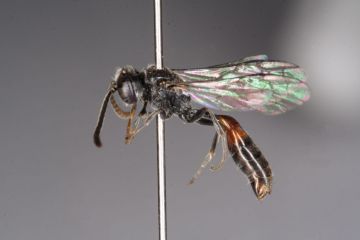Species Account for Mimesa bruxellensis
Mimesa bruxellensis (Bondroit, 1934)
a digger wasp
Aculeata: Crabronidae

Reproduction for study and non-profit use permitted, all other rights reserved.
Taxonomic group: bees and wasps (Aculeata) - County data
View time series maps for Mimesa bruxellensis
member log-on for taxon report
Status: Na
Essex RDB: Listed
Threat: Essex Endangered
Images
upload a new image
Species text
This is a scarce solitary wasp whose localised nature and possible preoccupation with tree foliage (as with many other 'Psen' species) may make it prone to under recording. Post-1970 records are available for about a dozen sites, mainly in south-east England (Falk, 1991b). It occurs in reasonably open, sunny situations on sandy soils. British records cover a variety of habitats, including heathland, dry grassland, open woodland, coastal dunes and disturbed situations such as sandpits. Cicadellid bugs such as Idiocerus spp. are the prey of this wasp and, as these species are associated with woodland, trees and shrubs must provide important hunting areas.The wasp burrows into sand at the roots of grasses in reasonably open, sunny situations on sandy soils. Until this survey, the wasp was thought likely to be extinct in Essex, the only previous site at Mill Wood Pit having been lost to housing as part fo the Chafford Hundred development. References
Habitats
Recorded management for locations with Mimesa bruxellensis
Recorded substrate and hydrology for locations with Mimesa bruxellensis
Why not join the Club, register and add a new species page
Interpretation of distribution maps



















